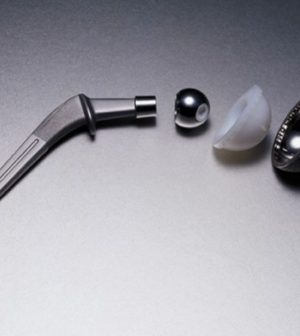- Skip Storing This Everyday Product in the Fridge Door
- Green Tea + B3 Pairing May Boost Brain Health
- Navigating Your Midlife Crisis: Embracing New Possibilities
- City Raccoons Showing Signs of Domestication
- Mapping the Exposome: Science Broadens Focus to Environmental Disease Triggers
- One Week Less on Social Media Linked to Better Mental Health
- Your Brain Changes in Stages as You Age, Study Finds
- Some Suicide Victims Show No Typical Warning Signs, Study Finds
- ByHeart Formula Faces Lawsuits After Babies Sickened With Botulism
- Switch to Vegan Diet Could Cut Your Greenhouse Gas Emissions in Half
Germs Grow on Medical Implants, But Can They Make You Sick?

Bacteria and fungi grow on medical implants, such as hip and knee replacements, pacemakers and screws used to fix broken bones, researchers report.
In a new study, Danish investigators examined 106 implants of different types and the surrounding tissue in patients. The findings showed that 70 percent of the implants had been colonized by bacteria, fungi or both.
However, none of the patients with bacteria or fungi on implants showed signs of infection, according to the team at the University of Copenhagen, Denmark.
“This opens up a brand new field and understanding of the interplay between the body and bacteria and microbiomes,” said study co-author Thomas Bjarnsholt, a professor in the university’s immunology and microbiology department.
“We have always believed implants to be completely sterile. It is easy to imagine, though, that when you insert a foreign body into the body, you create a new niche, a new habitat for bacteria,” he explained in a university news release.
“Now the question is whether this is beneficial, like the rest of our microbiome, whether they are precursors to infection or whether it is insignificant,” Bjarnsholt said.
None of the discovered bacteria or fungi were dangerous, the researchers said.
According to study co-author Tim Holm Jakobsen, “It is important to stress that we have found no direct pathogens, which normally cause infection. Of course if they had been present, we would also have found an infection.” Jakobsen is an assistant professor of immunology and microbiology.
“The study shows a prevalence of bacteria in places where we do not expect to find any. And they manage to remain there for a very long time probably without affecting the patient negatively,” he added.
“In general, you can say that when something is implanted in the body it simply increases the likelihood of bacteria development and the creation of a new environment,” Jakobsen said.
The study was published online July 2 in the journal APMIS.
More information
The U.S. National Institute of Arthritis and Musculoskeletal and Skin Diseases has more on joint replacements.
Source: HealthDay
Copyright © 2025 HealthDay. All rights reserved.










